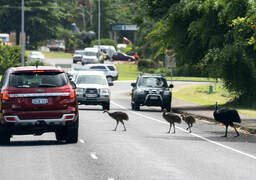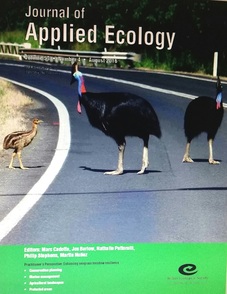Cassowary Sightings
Please send sighting information i.e., when (date), where, what time, how many and what were they doing to Jeff Larson: email - larsonjeff86@gmail.com. File below updated 22 February 2024. File goes back to 10 April 1991. File may take 2-3 minutes to download. If more info needed about sightings please email to the address above.
| Cassowary Sighting List autosaved_.xlsx | |
| File Size: | 4000 kb |
| File Type: | xlsx |
 Traffic stoppers!
Photo: Jeff Larson
Traffic stoppers!
Photo: Jeff Larson
We at C4 gather information from the Mission Beach community and its visitors, to help identify individual cassowaries, their movements, where they cross roads, their interactions, mating habits and dispersal of juveniles. It can also help us understand what day to day human activities or obstacles may place them at risk, such as fencing, loose dogs or interactions with people.
The data collected is held in a simple spread-sheet, and a copy is on this page for all to see. It will be regularly updated.
This information can inform authorities so appropriate planning can be put in place to help our endangered icon continue to not only survive, but thrive in their natural environment stronghold at Mission Beach. It is up to us all as a community to make sure this happens - even the smallest action made with consideration of how our everyday lives may affect the cassowary will help.
Because Mission Beach has the highest density of cassowaries in Australia, this is an incredibly important project. There may be only 50 adult cassowaries left in Mission Beach. It was listed as endangered in 1991 and development continues to encroach on its essential habitat. The cassowary is considered to be a keystone species, as it is the sole disperser of many large rainforest fruits and has a foraging range of up to 7 square kilometres. This makes it a major contributor to the health of the biodiversity of a mosiac of ecosystems.
We must protect the rainforest because: CASSOWARIES NEED FORESTS; FORESTS NEED CASSOWARIES.
The data collected is held in a simple spread-sheet, and a copy is on this page for all to see. It will be regularly updated.
This information can inform authorities so appropriate planning can be put in place to help our endangered icon continue to not only survive, but thrive in their natural environment stronghold at Mission Beach. It is up to us all as a community to make sure this happens - even the smallest action made with consideration of how our everyday lives may affect the cassowary will help.
Because Mission Beach has the highest density of cassowaries in Australia, this is an incredibly important project. There may be only 50 adult cassowaries left in Mission Beach. It was listed as endangered in 1991 and development continues to encroach on its essential habitat. The cassowary is considered to be a keystone species, as it is the sole disperser of many large rainforest fruits and has a foraging range of up to 7 square kilometres. This makes it a major contributor to the health of the biodiversity of a mosiac of ecosystems.
We must protect the rainforest because: CASSOWARIES NEED FORESTS; FORESTS NEED CASSOWARIES.
Journal of Applied Ecology - August 2016
Using citizen-collected wildlife sightings to predict traffic strike hot spots for threatened species: a case study on the southern cassowary Ross G. Dwyer1, Luke Carpenter-Bundhoo1, Craig E. Franklin1 and Hamish A. Campbell1,2*1School of Biological Sciences, The University of Queensland, St Lucia, Qld 4072, Australia; and 2Research Institute for the Environment and Livelihoods, School of Environment, Charles Darwin University, Darwin, NT 0810, Australia. Read the report in the download file below,. | |||||||
| Dwyer et al 2016-Journal of Applied Ecology 1_.pdf | |
| File Size: | 628 kb |
| File Type: | |
